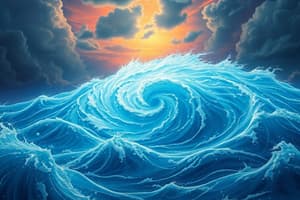Podcast
Questions and Answers
A storm is classified as a hurricane when its sustained wind speeds reach a minimum of:
A storm is classified as a hurricane when its sustained wind speeds reach a minimum of:
- 155 mph
- 73 mph
- 39 mph
- 74 mph (correct)
Which sequence correctly orders the stages of hurricane development from weakest to strongest?
Which sequence correctly orders the stages of hurricane development from weakest to strongest?
- Tropical Depression, Hurricane, Tropical Storm
- Tropical Depression, Tropical Storm, Hurricane (correct)
- Hurricane, Tropical Storm, Tropical Depression
- Tropical Storm, Tropical Depression, Hurricane
A Category 3 hurricane is generally considered more dangerous than a Category 1 hurricane due to:
A Category 3 hurricane is generally considered more dangerous than a Category 1 hurricane due to:
- Category 3 hurricanes form only over land, unlike Category 1.
- Lower wind speeds and less potential for flooding.
- Higher wind speeds and increased potential for structural damage. (correct)
- Similar wind speeds but different rainfall amounts.
Hurricanes in the Atlantic Ocean typically move from east to west. This is primarily due to:
Hurricanes in the Atlantic Ocean typically move from east to west. This is primarily due to:
Why are hurricanes unlikely to form over Oklahoma?
Why are hurricanes unlikely to form over Oklahoma?
The intensification of a tropical depression into a hurricane is primarily fueled by the release of energy from:
The intensification of a tropical depression into a hurricane is primarily fueled by the release of energy from:
If a tropical storm with wind speeds of 60 mph is approaching a coastal area, what is the most likely progression of this storm's classification if conditions favor intensification?
If a tropical storm with wind speeds of 60 mph is approaching a coastal area, what is the most likely progression of this storm's classification if conditions favor intensification?
Why is it important to consider all categories of hurricanes as potentially dangerous, even Category 1?
Why is it important to consider all categories of hurricanes as potentially dangerous, even Category 1?
Why does the area within the eye of a hurricane experience calm weather compared to other parts of the storm?
Why does the area within the eye of a hurricane experience calm weather compared to other parts of the storm?
Which of the following statements best describes the self-sustaining mechanism of a hurricane?
Which of the following statements best describes the self-sustaining mechanism of a hurricane?
Hurricanes weaken and dissipate when they move over land because:
Hurricanes weaken and dissipate when they move over land because:
Why are states like Oklahoma unlikely to experience hurricanes?
Why are states like Oklahoma unlikely to experience hurricanes?
What are the two main factors that can cause a hurricane to weaken or dissipate?
What are the two main factors that can cause a hurricane to weaken or dissipate?
Moist air cools, which means there is more condensation, which leads to more heat being generated. What is the scientific principle behind this phenomenon?
Moist air cools, which means there is more condensation, which leads to more heat being generated. What is the scientific principle behind this phenomenon?
If a hurricane is moving towards land, what measures can be taken to potentially weaken the storm's intensity before it makes landfall?
If a hurricane is moving towards land, what measures can be taken to potentially weaken the storm's intensity before it makes landfall?
Flashcards
Tropical Depression
Tropical Depression
A tropical, spinning storm with wind speeds less than 39 mph.
Tropical Storm
Tropical Storm
A tropical, spinning storm with wind speeds between 40 and 73 mph.
Hurricane
Hurricane
A tropical, spinning storm with wind speeds above 74 mph.
Category 1 Hurricane
Category 1 Hurricane
Signup and view all the flashcards
Category 5 Hurricane
Category 5 Hurricane
Signup and view all the flashcards
Hurricane Formation: Initial Stage
Hurricane Formation: Initial Stage
Signup and view all the flashcards
Energy Source of Hurricanes
Energy Source of Hurricanes
Signup and view all the flashcards
Why No West Coast Hurricanes?
Why No West Coast Hurricanes?
Signup and view all the flashcards
Condensation in Hurricanes
Condensation in Hurricanes
Signup and view all the flashcards
Hurricane 'Eye'
Hurricane 'Eye'
Signup and view all the flashcards
Hurricane as a Heat Engine
Hurricane as a Heat Engine
Signup and view all the flashcards
Hurricane Fuel
Hurricane Fuel
Signup and view all the flashcards
How Hurricanes Stop
How Hurricanes Stop
Signup and view all the flashcards
Hurricane Over Land
Hurricane Over Land
Signup and view all the flashcards
Inland Hurricane Impact
Inland Hurricane Impact
Signup and view all the flashcards
Study Notes
- Hurricanes have caused significant devastation and destruction, with notable examples including Hurricane Katrina (2005), Hurricane Irene (2011), and Superstorm Sandy (2012).
Hurricane Development
- A hurricane begins as a tropical depression, characterized by a tropical spinning storm with wind speeds below 39 mph.
- A tropical depression can intensify into a tropical storm, which is a tropical spinning storm with wind speeds between 40 and 73 mph.
- If a tropical storm continues to strengthen, it becomes a hurricane, a tropical spinning storm with wind speeds exceeding 74 mph.
Hurricane Categories
- Hurricanes are classified from 1 to 5 based on wind speed and potential damage, with higher numbers indicating stronger storms and greater damage potential.
- A category 1 hurricane, the weakest, has wind speeds between 74 and 95 mph.
- A category 5 hurricane, the strongest, has wind speeds of 155 mph or higher and can cause extensive damage, with Hurricane Andrew in 1992 as an example.
- All hurricanes, regardless of category, can be dangerous and cause damage.
Hurricane Movement and Formation
- Hurricanes typically move west across the Atlantic due to prevailing tropical winds originating in Africa, seldom affecting the U.S. West Coast.
- Hurricanes develop over oceans and weaken upon making landfall.
- Warm, moist air rising over tropical oceans leads to thunderstorm formation.
- As the air rises and cools, water condenses, leading to heavy rain.
- Horizontal diversion of wind causes the storm to spiral, potentially forming a tropical depression.
- Condensation of water vapor releases heat, intensifying the storm into a tropical storm or hurricane.
- The released heat causes the storm to rise further, drawing in surface air and creating a low-pressure area known as the 'eye' of the hurricane. The eye experiences calm weather compared to the storm's outer regions.
Hurricane Lifecycle
- Hurricanes are self-sustaining heat engines, fueled by the condensation of ocean water.
- Condensation releases heat, drawing moist air from the ocean into the eye of the storm.
- The cycle repeats as moist air cools, leading to further condensation and heat generation.
- Hurricanes dissipate when strong winds disrupt their flow over the ocean or when they move over land.
- Over land, hurricanes lose their energy source (ocean water), depriving them of the fuel needed to sustain themselves.
- States far inland, like Oklahoma, are rarely affected by hurricanes due to the distance from the ocean, and the hurricanes need a constant source of energy.
Studying That Suits You
Use AI to generate personalized quizzes and flashcards to suit your learning preferences.
Description
Explore the formation and classification of hurricanes. Learn how tropical depressions intensify into tropical storms and eventually become hurricanes. Understand the Saffir-Simpson Hurricane Wind Scale, which categorizes hurricanes from 1 to 5 based on wind speed and potential damage.




